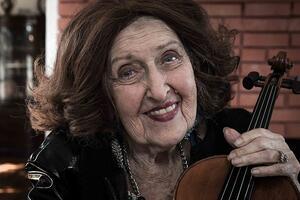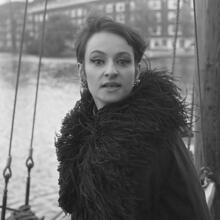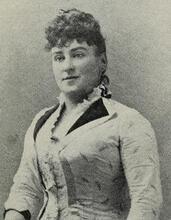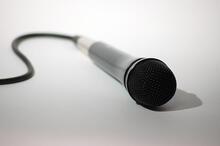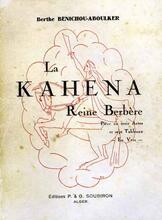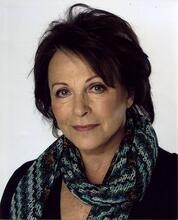Ida Haendel
Violinist Ida Haendel, 11 April 2016
From Wikimedia Commons.
A musical prodigy who began performing at age four, Ida Haendel continued her passionate violin performances into her late eighties. Haendel’s father took her to study at the Warsaw Conservatory, where she won the Conservatory’s gold medal at the age of four. She won the Polish Prize at age seven and placed seventh overall in the first Wieniawski Competition in 1935. She made her London debut at the Queen’s Hall, performed regularly throughout World War II at the Promenade and National Gallery concerts, and entertained British troops. Haendel left Britain in 1952 and finally settled in Miami in 1979. The British continued to esteem her, making her a Commander of the British Empire in 1991. Throughout her career, Haendel was praised for her masterclasses and her emotive recordings.
In a life that spanned the greater part of the twentieth century, Ida Haendel was one of the most enduring idols of the concert platform, an inspiration to both performers and music-lovers through her many recordings as well as her live performances and broadcasts.
Early Life and Family
Born in Chelm, Poland, on December 15, 1928, Ida Haendel was the younger of two daughters born to Nathan and Fela Hendel [sic]. Several sources state the year of her birth as 1923 or 1924. The confusion, Haendel claims, is the result of a performance she gave in London in 1937 when she was nine years old; just before she was to appear, her manager was informed that no performer was allowed to appear under the age of fourteen, and so he claimed that was indeed her age.
Her sister Ala, subsequently known as Alice, was six years old when Ida was born, and although quite different both physically and emotionally the two were always close friends. So convinced were her parents that their second child would be a boy that they decided to name her Isaac after her maternal grandfather, and did so in spite of her being a girl, reserving Ida as her unofficial first name; she claims that in this way “a masculine element was inculcated into me.”
Nathan Hendel was a portrait artist who earned a precarious living, thus subjecting the family to bouts of near penury. Although not particularly devout, the Hendels were traditional Jews, and Ida describes the celebratory Friday night meals that her mother provided whatever the state of the family’s finances. Besides being a gifted artist, Nathan had aspired to be a professional violinist and sought to fulfill his thwarted ambitions through an unwilling Ala, for whom he bought an instrument, subjecting her to lessons she did not enjoy. It was, however, Ida who displayed an extraordinarily instinctive affinity for the instrument: she describes the spring morning when, as a child of three at home with her mother, she took her sister’s violin from its case and began to play it for the first time. Although the instrument was much too large for her, her performance amazed both her mother and the neighbors who gathered to witness the event.
Education
Nathan swiftly transferred his attention to Ida, whom he took to Warsaw, where she studied under Miecyzslaw Michalowicz at the Conservatory and won the Conservatory’s gold medal in 1933 at the age of four. Thence Nathan took her to Germany, Paris, and London, studying first with Carl Flesch and later Georges Enescu. Teachers and musicians with whom she came into contact included Joseph Szigeti, Nikita Magalof, and Ignace Rubinstein, Artur Rubinstein’s brother, whom she met in Paris in the autumn of 1933. In 1935, aged seven, she won the Polish Prize at the first Wieniawski Competition in Warsaw, gaining seventh place overall. The first prize was awarded to the sixteen-year-old Ginette Neveu, while the second went to David Oistrakh, then aged twenty-seven; Neveu remained a friend and mentor to the young Ida Haendel until her untimely death in 1949. The intense passion with which the Hendels pursued Ida’s career reinforced a sense of isolation that the violinist claims was inherent in her character. However, she was fortunate that she had in the contemporary Wunderkind, Josef Hassid, a child experiencing a similar lifestyle with whom she could associate.
Performances in England
In 1937 she made her London debut at the Queen’s Hall under the baton of Henry Wood and subsequently made regular appearances at his Promenade concerts. It was at this time that her manager advised her to change the spelling of her surname from “Hendel” to “Haendel,” evoking associations with the composer of the same name. During World War II she was both a regular performer at the National Gallery concerts organized by Dame Myra Hess and also spent much time touring, entertaining the Allied troops, often under appalling conditions; she became a British citizen in 1940.
Later Career and the United States
In 1946 she went to the United States for the first time, touring extensively, and in 1952 settled in Montreal; in 1979 she moved to Miami. She was always a truly international artist, performing with many of the greatest conductors and soloists of the twentieth century, although her name is particularly associated with that of Sergiu Celibidache. In 2001, the BBC in London devoted a week of “live performances” to her, drawing on archive material interspersed with interviews with Haendel herself. Among the honors she has received is the Sibelius Prize, awarded to her in 1982 for her distinguished performances of the Sibelius Violin Concerto, for which she received the composer’s praise after he heard a radio broadcast of the work. In 1991 she was made Commander of the British Empire, and in 2000 she was awarded an honorary doctorate of the Royal College of Music, London. In 1970 she wrote her autobiography, Woman with Violin.
Having sustained her childhood promise in the first half of the twentieth century, Ida Haendel grew to become a legendary figure of the twenty-first.
Ida Haendel passed away from cancer on July 1, 2020.
Discography
Concerto No. 1 in G minor, Op. 26 violin. Max Bruch, Philharmonia Orchestra / Rafael Kubelík / Ida Haendel. 1948.
Concerto en ré majeur op. 61, pour violon et orchestre violin. Ludwig van Beethoven. Ida Haendel / Philharmonia Orchestra / Rafael Kubelík. 1955.
Famous Violin Compositions. Symphonie espagnole / Tzigane violin.. Édouard Lalo,Maurice Ravel, Czech Philharmonic Orchestra / Karel Ančerl / Ida Haendel. 1967.
Ida Haendel Plays Sibelius violin. Jean Sibelius, Bournemouth Symphony Orchestra / Paavo Berglund / Ida Haendel. 1976.
Violin Concerto violin. Edward Elgar, London Philharmonic Orchestra / Adrian Boult / Ida Haendel. 1978.
Bravissima! Ida Haendel Plays Favourite Violin Encores. 1980.
Konsert nr 2 för violin och orkester violin. Allan Pettersson, Radiosymfonikerna / Herbert Blomstedt / Ida Haendel. 1980.
Violin Concertos violin. Benjamin Britten,William Walton • Bournemouth Symphony Orchestra / Paavo Berglund / Ida Haendel, 1992.
Works for Violin & Piano violin. Karol Szymanowski,George Enescu,Béla Bartók,Zoltán Székely,Ludwig van Beethoven,Franz Schubert,Johannes Brahms,Fritz Kreisler,Pablo de Sarasate,Joseph Achron,Henryk Wieniawski,Isaac Albéniz,Manuel de Falla,Paweł Kochański, Ida Haendel. 2000.
Violin Concerto in D major, Op. 35 / Violin Concerto in E minor, Op. 64 / Introduction and Rondo Capriccioso in A minor, Op. 28. 2002.
Ida Haendel Plays Baroque Transcriptions (Ida Haendel; Geoffrey Parsons). 2002.
Grove, George, Stanley Sadie, John Tyrell, (eds.), New Grove Dictionary of Music and Musicians, New York: 2001.
Haendel, Ida, Woman With Violin, London: 1970.

